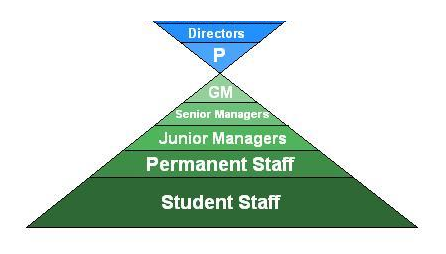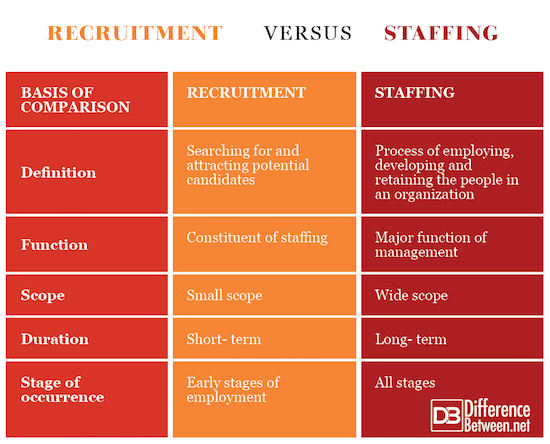Difference Between Recruitment and Staffing
Management involves the identification of an organizations objectives, procedures and rules through the manipulation of its structure. Management consists of five major structures which include planning, Organizing, Staffing, Directing and controlling. The structure of an organization is determined after thorough business planning has been performed. Planning explains what is going to be done; organizing explains how things will be done and staffing decides who will do it. Although staffing and recruitment highly contribute to the success of any organization, many people have no knowledge that they are different. Recruitment involves a process of acquiring the best potential for a particular job. Staffing is a process that involves several steps in acquiring suitable employees for several positions in an organization.
What is Recruitment?
Recruitment can be defined as a systematic process used to seek and acquire the best potential candidates for a job, from whom the candidate who best matches the requirements is selected. It involves getting as many applicants as possible from the pool of numerous job hunters. It is through recruitment that people get to hear and know about a company and also make a decision of whether they want to be part of the company or not.
The first thing an organization should do is to know how many employees they require and what skills should these people have so as to find the perfect match for the vacant position. An organization can choose to either use internal recruitment or external recruitment. Internal recruitment involves looking for a suitable candidate within the organization while external recruitment involves looking for a suitable candidate outside the organization.
The steps involved when recruiting include; identifying the need of hiring by being fully aware of the complete job description. Planning by identifying which communication channels will be used to get the word about the vacancy out there. Human resource then searches for the best potential candidates then identifies the most viable of them all and finally settles for the best few. The Chosen few undergo screening and interviewing and finally the best candidate is offered employment. The candidate is then hired and undergoes on boarding by making the new employee feel wanted before officially joining the organization.
What is Staffing?
Staffing is a managerial function which involves obtaining and maintaining proficient and fit employees to fill available positions from top level to bottom level of the corporate ladder. It involves obtaining the right person for the job, employing them and delightfully retaining them. It facilitates positioning, growth and progress of every employee in the organization so as to ensure that they effectively undertake their managerial and operational tasks. For a company to accomplish its goals, every employee has a role to play. Therefore, it is every individual’s responsibility to ensure that they fulfill their tasks efficiently and effectively. Staffing recognizes the importance of each and every employee in the organization. Human resource should therefore aim to get the best fit for any position available by carefully following a systematic process of hiring and development. This process ensures that the right number of candidates with the right qualifications is found at the right time.
The steps involved in the staffing process include; estimating the required manpower which involves determining the number and type of employees that are needed for the job available, recruitment by searching and motivating potential employees to apply for the vacancy, selecting the better applicants from the large number that showed interest for the job, placement and orientation of the right person who was selected due to his qualifications and abilities by putting him at the right place, training and development which is a systematic procedure of imparting knowledge and skills for the specified job, appraisal which is performed by comparing the actual work that has been done to the work that had been assigned and judgment is passed, promotion whereby an employee gets a better status and a better salary, compensation which involves giving employees incentives and finally separation which may be through death, termination, retrenchment or retirement.
Key Differences between Recruiting and Staffing
-
Definition
Recruitment is a process of looking for potential employees and encouraging them to apply for the vacant position while staffing is a process of acquisition, employment, development and retention of people in an organization.
-
Function
Recruitment is a constituent of staffing while staffing is a major function of management.
-
Scope
Recruitment is not as wide as staffing. Recruitment involves a single step while staffing involves a series of crucial steps recruitment being one of them.
-
Duration
Recruitment is a short term process while staffing is a long term and continuous process.
-
Stage of occurrence
Recruitment occurs in the early stages of employment while staffing occurs in all stages regardless of levels in an organization.
Recruitment vs. Staffing: Comparison Chart for you to easily identify the differences
Summary of Recruitment vs. Staffing
The main determinant of an organizations success is their employees. Every employee has to be skilled, committed and competent individuals.
The selected candidates should be people who are capable of fulfilling their tasks effectively and efficiently so as to positively contribute to the growth of the organization.
It is therefore very important for the human resource department to ensure that they follow a systematic process to make sure that they get the best fit for the vacant post.
It is only through the placement of the right people on a job that can help an organization achieve or even surpass their goals.
- Difference Between S Corp and C Corp - September 9, 2018
- Difference Between Terrace and Balcony - September 9, 2018
- Difference Between Anabaptists and Evangelicals - August 31, 2018
Search DifferenceBetween.net :
Leave a Response
References :
[0]Pearce, J. and Robinson, R. Strategic Management: Strategic Management; planning for domestic & global competition,[ McGraw-Hill/ Irwin Publishers, 2013 – Thirteenth Edition]
[1]French, J.R.P. & Raven, N. (2011). The bases of management. In D. Cartwright (Ed.), Studies in organization management practices, Ann Arbor: University of Michigan Press, pp.150-167.
[2]OECD. (2004), The OECD principles of Corporate Governance. http://www.oecd.org, Accessed April 2013.
[3]Image credit: https://www.maxpixel.net/Career-People-Opportunity-Recruitment-Employment-3185099
[4]Image credit: https://upload.wikimedia.org/wikipedia/commons/6/6b/Staffing_structure_pyramid.PNG



